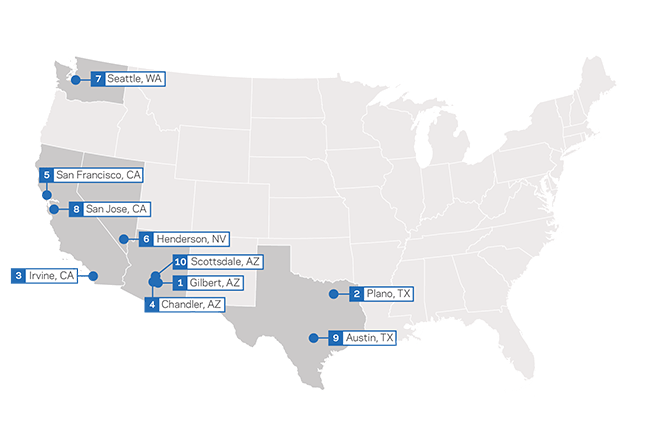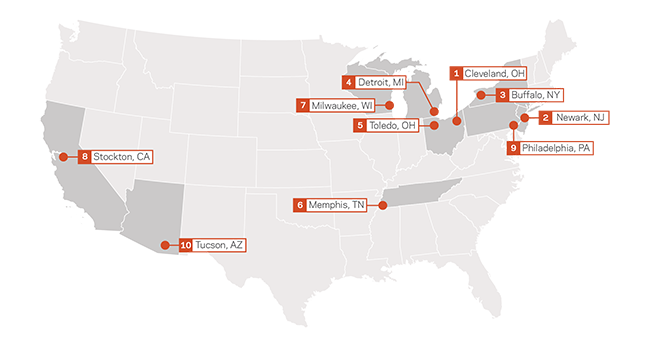Recession, recovery leave behind suffering communities

The most significant recession in modern history and the subsequent deeply uneven recovery has exacerbated the gap between wealthy communities and poorer areas, creating a patchwork map of economic haves and have-nots around the country.
Americans who live in the most economically prosperous areas are far more likely to attain higher educational achievements, earn more money and even live longer than those who live in the most economically distressed areas, a new report finds. And the differences between the areas that are succeeding and those that are struggling is growing.
{mosads}The report, produced by the Economic Innovation Group, finds the majority of new jobs created as the recovery began came in the 20 percent of American ZIP codes that were already the most prosperous. The 20 percent of ZIP codes in the least prosperous areas generated just 1 percent of jobs created between 2011 and 2015.
“It’s not just that there’s a large gap between the top and bottom communities,” said John Lettieri, the senior director for policy and strategy at the group. “It’s that the directional trajectory of the top and bottom are moving in opposite directions. The top is booming, and it’s doing so well that it’s obscuring a much more tepid picture below.”
Most new jobs are created by new businesses, and the top quintile of American ZIP codes accounted for 57 percent of new business starts between 2011 and 2015, the report found. Almost nine in ten of those ZIP codes experienced job growth between 2011 and 2015.
By contrast, more than half the ZIP codes in the bottom quintile — which the report dubs “distressed communities” — had fewer jobs and fewer business establishments in 2015 than they did in 2000. Since then, America’s population has grown by more than 40 million.
More than half the ZIP codes in Michigan and Ohio, and more than 45 percent in Alabama, Mississippi, Illinois and Indiana, have fewer jobs and fewer businesses now than they did in 2000.




It is as if those communities that have struggled the most in recent years have been in the midst of a recession since the turn of the century, Lettieri said.
“If you don’t have new business creation, then you can’t get the new jobs that go with it,” he said. “This has been a top-tier recovery for communities just like it has been for individuals.”
The lowest tier communities cut across demographic and geographic lines, said Steve Glickman, EIG’s executive director. Aging industrial cities in the Rust Belt have high levels of distressed communities, and so do mainly white agricultural areas in the Midwest, the South and even parts of California, where automation is reducing economic opportunity for workers who once tilled the fields.
“Distressed communities come in all shapes and sizes,” Glickman said.
Rural areas and smaller towns are most likely to be distressed over the long term. So are majority-minority communities in Rust Belt industrial cities. Both were hubs of job creation during much of the 20th century, but both have fallen behind since the turn of the century.
Cleveland, Ohio; Newark, N.J.; Buffalo, N.Y.; Detroit, Mich.; and Toledo, Ohio, are the five most economically distressed major cities in America. All have experienced major job losses as manufacturing jobs vanished during the recession. All but two of the most distressed small- and mid-sized cities are in Rust Belt or Northeastern states. Rural Albany, Ga., and Hemet, Calif., are the lone exceptions.
“They’re in trouble now, and they lack the capacity to pull their way out of that without some type of paradigm shift,” Lettieri said.
Fifty-two million Americans live in the most distressed ZIP codes across the nation. Those people are disproportionally likely not to have graduated from high school. The poverty rate in those communities is 11 points higher than the national average. And adults in those communities are twice as likely to be out of work than in the wealthiest counties.
They are also far more likely to live near brownfields, sites polluted or contaminated enough that the Environmental Protection Agency is working to clean them up before reuse or redevelopment can proceed. There are nearly 13,000 brownfield sites in distressed ZIP codes, compared to 3,700 in the most prosperous ZIP codes.
Those who live in distressed areas have a life expectancy almost five years shorter than those who live in prosperous areas. Rates of cancer, suicide and violence are all markedly higher in the poorest areas, and substance abuse disorders are 64 percent more likely, the report found.
The most prosperous areas in America are mostly big cities where the tech industry has produced thousands of new jobs since the recession, including Seattle, San Francisco and San Jose, Calif. Others are wealthy suburbs of growing Western cities, like Scottsdale, Gilbert and Chandler, Ariz., outside Phoenix; and Henderson, the Las Vegas suburb.
Suburbs of Denver; Minneapolis; Dallas; Austin, Texas; and San Antonio also make the list of most prosperous areas.
“Prosperous cities tend to be new, young and fast-growing,” Lettieri said. “This is geographically the most concentrated recovery on record.”
Copyright 2023 Nexstar Media Inc. All rights reserved. This material may not be published, broadcast, rewritten, or redistributed.

